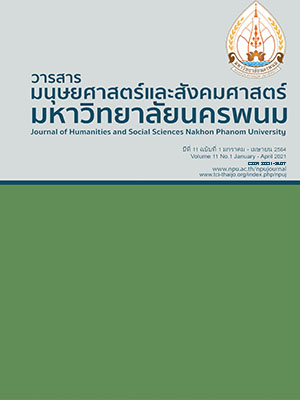Guidelines for the Creative Economy: Enhancing the Value of Cultural and Natural Resources in the Peripheral City, Chanthaburi province of Thailand
Main Article Content
Abstract
The purposes of this study were to study the value of cultural and natural resources which were the tourism places of Chanthaburi province, to understand the relationship between the application of creative economy in the peripheral city and the tourists’ experiences which were derived by the collaboration (Quadruple Helix) and co-creation of value, and to study the comparative case study of the application of creative economy in other cities such as Sawankhalok district, Sukhothai province and Khon Kaen Province from which were benefited from the application of collaboration (Quadruple Helix) and co-creation of value. The research method was the combination method between quantitative and qualitative approaches. The research instruments were the questionnaire which was tested for the scores of ‘reliability’ and Index of Item-Objective Congruence (IOC) by 3 experts. The interview questions were made in the semi-structure. The samples of study were 590 visitors who visited at the cultural and natural tourism places of Chanthaburi province and 20 key informants. Statistics used in quantitative data analysis were mean, cross-tab analysis, and correlation analysis. For the qualitative approach, the descriptive analysis was applied. The findings disclosed that the cultural and natural resources of Chanthaburi were abundant and various and the tourists’ experience and the application of creative economy model had a significant positive relationship. Additionally, the guidelines for creative economy enhancing the value of cultural and natural resources in the peripheral city were the collaboration (Quadruple Helix) and co-creation of value which the local universities played key roles in supporting such collaboration and co-creation of value.
Article Details
References
Collins, P., & Cunningham, J. A. (2017). Creative Economies in Peripheral Regions. Springer Nature.
Hauge, E. S., Pinheiro, R. M., & Zyzak, B. (2016). Knowledge bases and regional development: collaborations between higher education and cultural creative industries. International Journal of Cultural Policy, 24(4), 485-503.
Kolehmainen, J., Irvine, J., Stewart, L., Karacsonyi, Z., Szabo., Alarinta, J., & Norberg, A. (2015). Quadruple Helix, Innovation and the Knowledge-Based Development: Lessons from Remote, Rural and Less-Favoured Regions. Journal of the Knowledge Economy, 7(2016), 23-42.
OECD. (2014). Tourism and the Creative Economy. Paris: OECD Publishing.
Leclercq, T., Hammedi, W., & Poncin, I. (2016). Ten years of Value Cocreation: An Integrative Review. Retrieved May 2019, from https://dial.uclouvain.be/pr/boreal/object/boreal:169488/datastream/PDF_01/view
Lo, M.C., Mohamad A.A., Chin, C.H., & Ramayah, T. (2017). The impact of natural resources, cultural heritage, and special events on tourism destination competitiveness: the moderating role of community support. International Journal of Business and Society, 18 S4 (2017), 763-774.
Križanović, K., Lubar, H. M., & Gajos, M. (2014). Importance of Triple (Quadruple) Helix Concept for Regional Development-Case Study” Faculty of Economics in Osijek. Doctoral dissertation, University of J.J. Strossmayer in Osijek, Faculty of Economics in Osijek.
Plé L and Cáceres RC (2010) Not always co-creation: introducing interactional co-destruction of value in service-dominant logic. Journal of Services Marketing. 24(6): 430-437.
Prahalad, C. K., & Ramaswamy, V. (2004). Co-creation experiences: The next practice in value creation. Journal of Interactive Marketing, 18(3), 5-14.
Vargo, S. L., & Lusch, R. (2008). Service-dominant logic: continuing the evolution. Journal of the Academy of Marketing Science, 36(1), 1-10.
Yupakaset, W. (2019). Creative City: Long Poed Chai Hai Mueang Rong. Creative Thailand, 10(7), 24-27.


